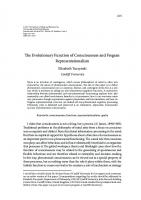Icon and Idea: The Function of Art in the Development of Human Consciousness [Reprint 2014 ed.] 9780674435308, 9780674435292
191 10 18MB
English Pages 161 [252] Year 1955
PREFACE
CONTENTS
ILLUSTRATIONS
I THE VITAL IMAGE
II THE DISCOVERY OF BEAUTY
III SYMBOLS FOR THE UNKNOWN
IV THE HUMAN AS THE IDEAL
V THE ILLUSION OF THE REAL
VI FRONTIERS OF THE SELF
VII THE CONSTRUCTIVE IMAGE
REFERENCES
INDEX
Recommend Papers
![]()
- Author / Uploaded
- Herbert Read
File loading please wait...
Citation preview
THE CHARLES ELIOT N O R T O N LECTURES I953-I954
ICON AND
IDEA The Function ofArt in the Development of Human Consciousness
HERBERT
READ
1955
HARVARD UNIVERSITY PRESS CAMBRIDGE,
MASSACHUSETTS
The Charles Eliot Norton Lectures at Harvard University Published in the United States of America by Harvard University Press First published
1955
P R I N T E D BY W . S. C O W E L L L I M I T E D A T THEIR PRESS IN THE B U T T B R M A R K E T ,
IPSWICH
IN THE C O U N T Y OF S U F F O L K , E N G L A N D
PREFACE SOME apology must first be made for presenting a somewhat revolutionary theory in what may strike the reader as a perfunctory manner. A brevity of treatment and a directness of style were imposed by the manner in which the book was conceived—as a series of seven lectures. When, in 1953,1 was invited to give the Charles Eliot Norton Lectures at Harvard University, I chose this theme because it was uppermost in my mind, and because I was anxious to test its viability before an intelligent audience. The generous welcome it received on that occasion encourages me to offer it, inadequate though it be, to a wider public. I do not claim to be the originator of the theory now presented. As I make clear in the first chapter, the germ of it is latent in the neglected works of Conrad Fiedler, and it is also an obvious (though not an authorized) deduction from Cassirer's philosophy of symbolic forms. Cassirer claimed that every authentic function of the human spirit embodies an original, formative power. Art, myth, religion, cognition—"all live in particular image-worlds, which do not merely reflect the empirically given, but which rather produce it in accordance with an independent principle." Cassirer believed that each of these functions of the human spirit creates its own symbolic forms, and that these forms enjoy equal rank as products of the human spirit. "None of these forms can simply be reduced to, or derived from, the others; each of them designates a particular approach, in which and through which it constitutes its own aspect of 'reality'." I do not question this "equality" among symbolic forms, as current instruments of discourse. But in this book I am attempting to establish for the symbols of art a claim to priority which is historical. I believe that to some extent Cassirer does this too, though never systematically nor with any realization of the consequences of such an act. For if the image always precedes the idea in the development of human consciousness, as I maintain it does, then not only must we rewrite the history of culture but we must also reexamine the postulates of all our philosophies. In particular, we must ask ourselves once again what is the right basis of education. To make such immense claims in seven brief lectures is an - 5 -
PREFACE impertinence, but no one could be more conscious than myself of my inadequacy for the major task of consolidating a theory so lightly entertained. It would require a detailed knowledge of the comparative history of civilizations, particularly the formative phases of such civilizations; and in secure possession of all the relevant facts, a logical ability to order them in a systematic fashion. I have neither this knowledge nor this ability, nor time left in my life to acquire either. But I have an ardent conviction of the truth of my hypothesis, and I think it is sufficiently firmly based on experience to be cast to the critical lions. I gave a first outline of the theory in a lecture (the Conway Memorial Lecture) delivered in London in April 1951. The separate publication of that lecture led to correspondence and discussion which has done much to correct the first outline, and in particular I was grateful to Dr. Julian Huxley for a warning against the imprecise use of the word "evolution." "Development" may be merely a more ambiguous word, and one dare not speak of progress in the image-world of art. Images, once created, are everlasting—or last as long as they have sensuous acuity. But much depends on our ability to create them and on their enduringness—certainly all we imply by the word progress in the world of ideas. We manipulate ideas by logic or scientific method, but we come upon them in the contemplation of images. But I begin to anticipate my argument.. . . I have many obligations to record—and, first of all, my obligation to the President and Fellows of Harvard College, and to the Norton Professorship Committee, for the honor they conferred on me. During my stay in Cambridge, I enjoyed the hospitality of Lowell House, for which my sincere thanks are given to Dr. and Mrs. Elliott Perkins. My immediate mentor was Professor Frederick Deknatel, chairman of the Department of Fine Art, and to him, and to Mr. John Coolidge, the Director of the Fogg Museum of Art, my obligations were continuous during my stay of eight months. I would also like to thank Miss Ward and Miss Lucas, and the remainder of the staff of the library of the Fogg Museum, for their unfailing courtesy and help in the preparation of the lectures. H. R.
August 1954
- 6 -
CONTENTS
ILLUSTRATIONS I
9
T H E V I T A L IMAGE
17
T H E D I S C O V E R Y OF B E A U T Y
35
III
S Y M B O L S FOR THE U N K N O W N
53
IV
T H E H U M A N AS THE I D E A L
73
V
T H E I L L U S I O N OF THE R E A L
87
II
VI VII
F R O N T I E R S OF THE S E L F
107
T H E CONSTRUCTIVE IMAGE
125
INDEX
153
ILLUSTRATIONS The sources of the photographs reproduced are indicated in the following list. Where there is no indication, the photograph is either an official one, supplied by the museum or gallery in question, or is from an unknown source. The photograph of the drawing at Windsor Castle (Plate 63) is reproduced by gracious permission of Her Majesty the Queen. 1
Finger drawings o n clay. Pech-Merle cave near Cabrerets (Lot), France Photo: Laborie.
2
Heads o f oxen f r o m the cave at Lascaux near Montignac-sur-Vézére ( D o r dogne). Photo: Service Commercial Monuments Historiques.
3
Frieze o f animals f r o m the cave at Lascaux. Photo: Laborie.
4
Fight o f archers. F r o m a cave near Morella la Vella, province o f Castellón, Spain. After a drawing b y F. Benitez.
J
Part o f the frieze o f animals and hunters, painted in black and red, at C u e v a Vieja, Alpera (Albacete), Spain. A f t e r J. Cabré A g u i l o , El arte rupestre en España (Madrid, 1915).
6a O x and horses f r o m the cave at Lascaux. Photo: Service Commercial Monuments Historiques. 6b Male k o o d o o f r o m the N s w a t u g i cave, Whitewaters, Southern Rhodesia. M c G r e g o r M u s e u m , Kimberley. 7
Nine-square checkered design f r o m the cave at Lascaux. Polychrome, 24 x 24 c m . T h e h o o f o f an o x breaks into the upper outline. Photo: Archives photographiques, Paris.
8
C r o u c h e d bison f r o m the cave at Altamira, near Santander (Spain). P o l y chrome, painted o n a natural relief, b e y o n d w h i c h the horns and tail project. Length: 185 cm. Photo: Laborie.
9« Horse engraved and painted in bistre f r o m the cave at Lascaux. Photo: Archives photographiques. 9b A n i m a l (li-yu) o f cast bronze. Chinese ( C h o u dynasty: about eleventh to ninth century B.C.). Freer Gallery o f A r t , W a s h i n g t o n , D . C . io








